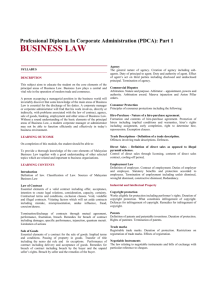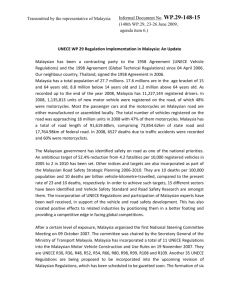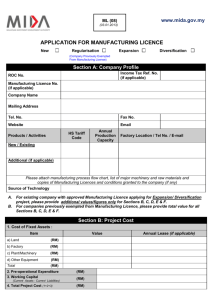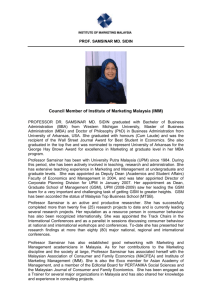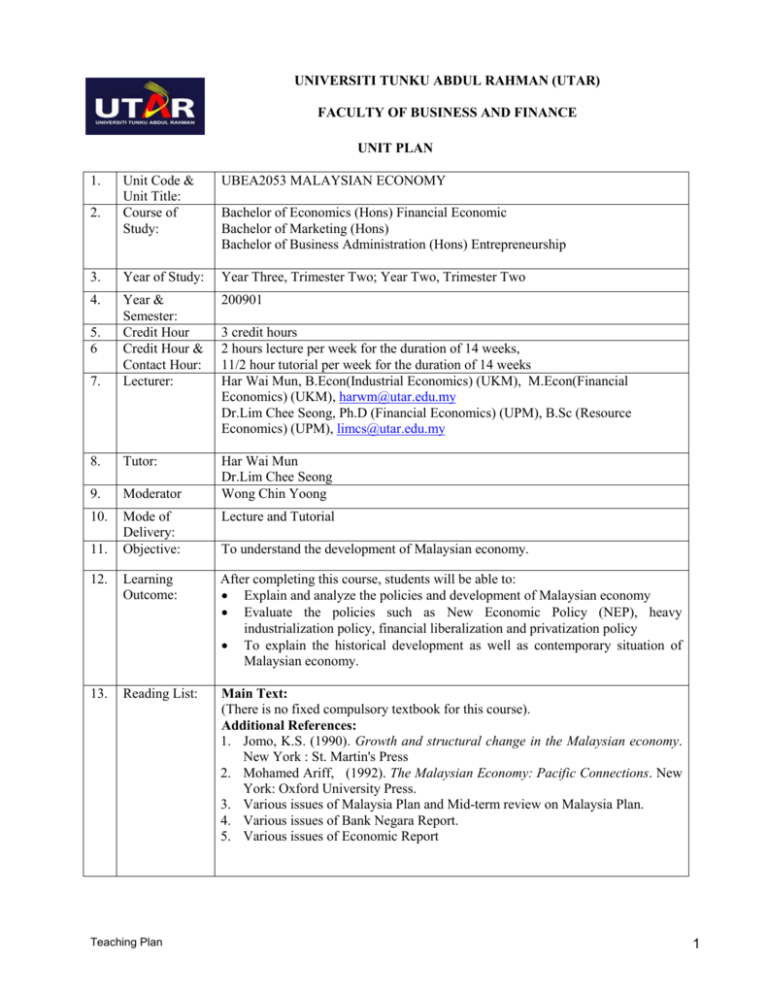
UNIVERSITI TUNKU ABDUL RAHMAN (UTAR)
FACULTY OF BUSINESS AND FINANCE
UNIT PLAN
1.
Unit Code &
Unit Title:
Course of
Study:
UBEA2053 MALAYSIAN ECONOMY
3.
Year of Study:
Year Three, Trimester Two; Year Two, Trimester Two
4.
200901
7.
Year &
Semester:
Credit Hour
Credit Hour &
Contact Hour:
Lecturer:
8.
Tutor:
9.
Moderator
Har Wai Mun
Dr.Lim Chee Seong
Wong Chin Yoong
10.
Mode of
Delivery:
Objective:
Lecture and Tutorial
12.
Learning
Outcome:
After completing this course, students will be able to:
Explain and analyze the policies and development of Malaysian economy
Evaluate the policies such as New Economic Policy (NEP), heavy
industrialization policy, financial liberalization and privatization policy
To explain the historical development as well as contemporary situation of
Malaysian economy.
13.
Reading List:
Main Text:
(There is no fixed compulsory textbook for this course).
Additional References:
1. Jomo, K.S. (1990). Growth and structural change in the Malaysian economy.
New York : St. Martin's Press
2. Mohamed Ariff, (1992). The Malaysian Economy: Pacific Connections. New
York: Oxford University Press.
3. Various issues of Malaysia Plan and Mid-term review on Malaysia Plan.
4. Various issues of Bank Negara Report.
5. Various issues of Economic Report
2.
5.
6
11.
Teaching Plan
Bachelor of Economics (Hons) Financial Economic
Bachelor of Marketing (Hons)
Bachelor of Business Administration (Hons) Entrepreneurship
3 credit hours
2 hours lecture per week for the duration of 14 weeks,
11/2 hour tutorial per week for the duration of 14 weeks
Har Wai Mun, B.Econ(Industrial Economics) (UKM), M.Econ(Financial
Economics) (UKM), harwm@utar.edu.my
Dr.Lim Chee Seong, Ph.D (Financial Economics) (UPM), B.Sc (Resource
Economics) (UPM), limcs@utar.edu.my
To understand the development of Malaysian economy.
1
14.
Method of
Assessment:
No.
1.
Method of Assessment
Coursework
a) Short research paper
Written essay
20%
Presentation
5%
b) Mid-term exam
Total
2.
Final Examination
GRAND TOTAL
Total
40%
25%
15%
40%
60%
100%
1. Coursework Assessment (40%)
a) Group Assignment (group) 25%
Students (four persons per group) are required to write a short research paper on
the selected theme that is relevant to the subject. The paper could contain either
theoretical, empirical analysis or case study, whichever deem most suitable. The
written essay should be in between 6 to 7 pages with 1.5 spacing & Times New
Roman font size of 12. The submission due date of written paper falls on Week 5
lecture class. The schedule of presentation is stated in Teaching Plan as arranged
by respective lecturers/tutors.
Generally, each assignment may consist of the following (as necessary):
1. Introduction (inclusive of the literature review and objective)
2. Theoretical / conceptual illustration (if any).
3. Empirical / case studies
4. Implication to economy (in near future)
5. Conclusion
6. Reference
A complete reference should contain the following information:
The names(s) of the author(s)
The date of publication
The title of the article
The name of the journal or magazine
The volume number, issue number (if any), and page number.
For the articles from the Internet, the reference should contain the web site address
and the date of access, in addition to the information stated above. Presentation is
evaluated based on the clarity and response to the question and opinions.
1
2
3
4
Marking Guidelines for Group Assignment
Assessment
Marks Allocation
Originality and Relevancy of idea,
10%
Profundity of analysis, and overall
impact
Contribution to the field of study
8%
Structural layout & References
2%
Presentation
5%
Total Marks
25%
b) Mid-term exam (individual) 15%
The mid-term exam will be on the Saturday of Week 7.
Teaching Plan
2
Late Submission Penalty Clause
Deadline for submission of assessment item(s) is to be strictly adhered to. No
extension of time will be allowed except in extenuating circumstances, e.g.
medical reasons. Students who wish to apply for extension of time for submission
of assessment item(s) after the due date shall put in writing the request together
with validated documentary evidence to support the application to his/her class
tutor. The lead lecturer may consider and grant such extension of due date for the
assessment item(s) based on the tutor's recommendation.
Any assessment item required by the Coursework Assessment, which is submitted
after the due date, without an approved extension, will be penalized. A penalty of
10% reduction of the maximum mark applicable to the assessment item(s) will be
levied for each day of late submission. Weekends and public holidays are counted
as one day late.
15.
Remark:
2. Final Examination (60%)
The final examination for this subject will be 2.5 hours and consist of TWO
sections:
Section A (40 marks) = 1 compulsory question.
Section B (60 marks) = 3 questions in which students are required to answer any 2
questions
All students should achieve a minimum 40 marks for final examination to pass this
paper. Otherwise, students will have to sit for the supplementary exam.
ACADEMIC REGULATIONS
Plagiarism
Plagiarism is defined as the submission or presentation of work, in any form,
which is not one's own, without acknowledgment of the sources. If a student
obtains information or ideas from an outside source, that source must be
acknowledged. Another rule to follow is that any direct quotation must be placed
in quotation marks and the source immediately cited. Plagiarism is also defined as
copy of all or part of the work of another student(s) of current or previous batch of
this
University
or
another
higher
learning
institution.
The University's degree and other academic awards are given in recognition of the
candidate's personal achievement. Plagiarism is therefore considered as an act of
academic fraudulence and as an offence against University discipline.
Intellectual Property
Copyright must be seriously protected. The University takes a strong stand against
any illegal photocopying of textbooks and any other materials by students.
Students are forewarned of the consequences and the penalty that may be meted
out if they are "caught in the act".
Mode of Referencing
Students are advised to incorporate proper academic modes of referencing. The
normally acceptable mode of academic referencing is the American Psychological
Association (APA) system; please refer to the attached APA referencing system
document for detailed usage.
Teaching Plan
3
TEACHING PLAN
Lecture, Tutorial & Assignment Plan
Week
Topics / Learning Outcome
1
(12/1/09-16/1/09)
01: A
brief history of Malaysian economic development
Heavy reliance on tin and rubber
Diversifying into palm oil industry
Industrialization
The development of services sectors
Learning outcome:
Tutorial/
Assignment
Tutorial 1:
2 questions for
discussion.
Reference1
Yip, Y.H
(1966); Barlow
(1985)
Briefing on
students’
assignments.
Student should be able to describe the early phrases of Malaysian
economic progress.
2
(19/1/09-23/1/09)
02: Economic planning of Malaysia
Early stage of planning ( includes First Malaya Plan, Second
Malaya Plan and First Malaysia Plan, 1956-1970)
The New Economic Policy (NEP) (includes Second to Fifth
Malaysia Plan, 1971-1990)
The Second Outline Perspective Plan (OPP2) (includes Sixth and
Seventh Malaysia Plan, 1991-2000)
The Third Outline Perspective Plan (OPP3) (includes Eighth and
Ninth Malaysia Plan, 1991-2000)
Tutorial 2:
4 questions for
discussion.
Thillainathan
(1970);
Okposin, Abd
Halim & Ong
(1999)
Tutorial 6:
Students’
presentations.
Poon (2005);
Okposin, Abd
Halim & Ong
(1999)
Tutorial 3:
4 questions for
discussion.
Lim (1970);
Khong (1986);
Jomo (1993);
Jomo &
Edwards (1993);
Okposin, Abd
Halim & Ong
(1999)
Learning outcome:
Student should be able to analyze and debate on the economic plans.
6
(16/2/09-20/2/09)
04: Agricultural policy
Structural change (focus on rubber, palm oil and rice)
New Agricultural Policy (1992-2010)
Learning outcome:
Student should be able to describe the agricultural policy.
3
(2/2/09-6/2/09)
4
(26/1/09-30/1/09)
5
(9/2/09-13/2/09)
03: Industrialization
Import-substituting industrialization (ISI) (1958-1968)
Export-oriented industrialization (EOI) (1969-1980)
Heavy industrial policy (second phase of ISI (1981-1986)
Second phase of EOI (from 1987 onwards)
Learning outcome:
Student should be able to debate on industrialization progress and related
policies.
Tutorial 4:
4 questions for
discussion.
Submission of
group assignment
on WEEK 5.
Tutorial 5:
4 questions for
discussion.
7
(23/2/09-27/2/09)
05: Investment policy
Special economic zone, foreign direct investments
Learning outcome:
Student should be able to analyze foreign investment policies.
Tutorial 7:
3 questions for
discussion
Students’
presentations.
Tan, Gerald
(1978);
Poon (2005)
Mid-term exam
(Saturday)
1
Refer to list of book chapters, journals and articles used as reading materials.
Teaching Plan
4
8
(2/3/09-6/3/09)
06: Privatization
Objectives, arguments (for and against), forms and achievements
Reversal of policy (eg. MAS, LRT, PLUS)
Tutorial 8:
4 questions for
discussion.
Wong, Jomo &
Chin (2005);
Gomez (2002);
Okposin, Abd
Halim & Ong
(1999)
Tutorial 9:
2 questions for
discussion
Students’
presentations.
Lin (1990);
Wong, Jomo &
Chin (2005);
Har, Looi & Ho
(2006)
Learning outcome:
Student should be able to debate on the success & failure of privatization.
9
(9/3/09-13/3/09)
&
07: Financial markets
The development of capital markets (share and bond markets)
The development of money markets
Financial liberalization
10
(16/3/09-20/3/09)
Learning outcome:
11
(23/3/09- 27/3/09)
08: The Asian financial crisis 1997-98
Student should be able to describe the financial market structure and
development in Malaysia.
Causes, response (include capital control, Danaharta, Danamodal as
well as capital and money market reform) and implications
Tutorial 10:
Students’
presentations.
Tutorial 11:
4 questions for
discussion.
Daim Zainuddin
(1998);
Obiyathulla
Ismath Bacha
(1998);
Tan (1997)
Tutorial 12:
4 questions for
discussion
Har, Looi & Ho
(2006)
Tutorial 13:
2 case studies.
Poon (2005)
Learning outcome:
Student should be able to analyze and comment on the crises happened in
Asia, particularly in Malaysia.
12
(30/3/09-3/4/09)
09: Fiscal and monetary policy issues
Various contemporary and past issues and debates.
Learning outcome:
Student should be able to analyze and debate on previous as well as
contemporary fiscal and monetary policies.
13
(6/4/09-10/4/09)
10: Other policies
Rural development (includes land reform & agricultural reform)
Technology policy
Human resources policy
Environmental policy
Learning outcome:
Student should be able to describe and comment on various Malaysian
policies regarding socio-economic.
14
(13/4/09-17/4/09)
Revision
Tutorial 14:
2 questions for
discussion.
Revision
Notes: The information provided in this Unit Plan is subject to change by the Lecturers.
Books and journals used as reading materials
Barlow C. (1985). Institutional and policy implications of economic change: Malaysian rubber 1950 – 1985.
Kajian Ekonomi Malaysia. Vol 22 (2): 57 – 76.
Daim, Z. (1998). The regional financial crisis: The Malaysian experience. Malaysian Journal of Economic
Studies. Vol 35 (1 & 2): 7 – 10.
Terence G. (2002). Political business in Malaysia: party factionalism, corporate development, and economic
crisis. In Gomez, Edmund Terence (ed). 2002. Political business in East Asia. London: Routledge: 82 –
114.
Teaching Plan
5
Har,
W.M.
(ed).
2007.
Malaysian
Economic
Development.
http://www.harwaimun.com/Malaysian_Economics_Development.pdf.
Available
at
Har W. M., Looi K.Y. & Ho L. P. (2006). Economics. Kuala Lumpur: Pearson Prentice-Hall. [Refer Chapter
12, 13 & 14].
Jomo, K.S. (1993). Prospects for Malaysian industrialization in light of East Asian NIC experiences. In Jomo,
K.S. (ed). 1993. Industrializing Malaysia: Policy, performance, prospect. London: Routledge: 286 – 301.
Jomo, K.S. & Edwards, C. (1993). Malaysian industrialization in historical perspective. In Jomo, K.S. (ed).
1993. Industrializing Malaysia: Policy, performance, prospect. London: Routledge: 14 – 39.
Khong H. L. (1986). Export-oriented industrialization, employment and real wages in Malaysia. Kajian
Ekonomi Malaysia. Vol 23 (2): 1 – 29.
Lim, D. (1970). Export-oriented industrialization: A case study of Malaysia. Kajian Ekonomi Malaysia. Vol 7
(2): 17 – 25.
Lim K. H. & Har W. M. (2007). Globalisasi, media & budaya: Antara hegemoni Barat dengan kebangkitan
Asia. Kuala Lumpur: Dewan Bahasa dan Pustaka. Available at UTAR library (Call number: P94.6.L56
2007) [reference for group assignment].
Lin, S. Y. (1990). Productivity in the banking system, 1979 – 90. Malaysian Journal of Economic Studies.
Vol 27 (1 & 2): 65 – 87.
Bacha, O.I. (1998). Malaysia: From currency to banking crisis. Malaysian Journal of Economic Studies. Vol
35 (1 & 2): 73 – 94.
Okposin, S. B., Abdul Halim & Ong, H. B.( 1999). The changing phrases of Malaysian economy. Subang
Jaya: Pelanduk Publication. [Refer Chapter 2, 3, 7 & 10].
Poon, W. C. (2005). The development of Malaysian economy. Kuala Lumpur: Pearson Prentice-Hall. [Refer
Chapter 2, 7, 9 & 10].
Tan, E. C. (1977). The present Malaysian economic crisis with reference to the crisis of mid-1980s.
Malaysian Journal of Economic Studies. Vol 34 (1 & 2): 113 – 1214.
Tan, G. (1978). Foreign investment and employment generation in Malaysia. Kajian Ekonomi Malaysia. Vol
15 (1): 19 – 24.
Thillainathan, R. (1970). The Second Malaysia Plan – Notes on the objectives of balanced distribution of
wealth and employment. Kajian Ekonomi Malaysia. Vol 7 (2): 57 – 71.
Wong, S. C., Jomo, K.S. & Chin, K. F. (2005). Malaysian “bail outs”?: Capital controls, restructuring and
recovery. Singapore: Singapore University Press. [Refer Chapter 5 & 6].
Yip, Y. H. (1966). Development prospects of the Malayan tin mining industry. Kajian Ekonomi Malaysia.
Vol 3 (1): 25 – 40.
Notes: The information provided in this Unit Plan is subject to change by the Lecturers.
Teaching Plan
6




